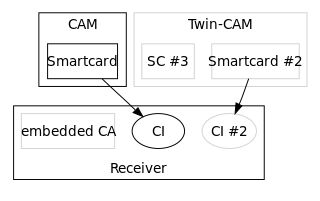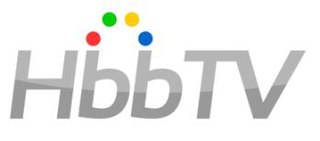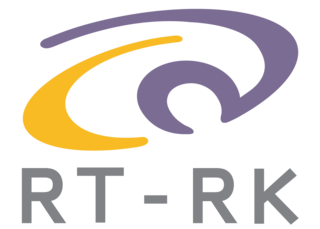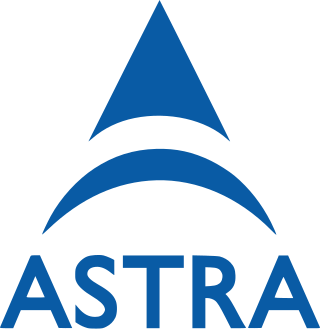Related Research Articles

Digital Video Broadcasting (DVB) is a set of international open standards for digital television. DVB standards are maintained by the DVB Project, an international industry consortium, and are published by a Joint Technical Committee (JTC) of the European Telecommunications Standards Institute (ETSI), European Committee for Electrotechnical Standardization (CENELEC) and European Broadcasting Union (EBU).
MHEG-5, or ISO/IEC 13522–5, is part of a set of international standards relating to the presentation of multimedia information, standardised by the Multimedia and Hypermedia Experts Group (MHEG). It is most commonly used as a language to describe interactive television services.
Multimedia Home Platform (DVB-MHP) is an open middleware system standard designed by the DVB project for interactive digital television. The MHP enables the reception and execution of interactive, Java-based applications on a TV-set. Interactive TV applications can be delivered over the broadcast channel, together with audio and video streams. These applications can be for example information services, games, interactive voting, e-mail, SMS or shopping. MHP applications can use an additional return channel that has to support IP.

Digital Video Broadcasting - Satellite - Second Generation (DVB-S2) is a digital television broadcast standard that has been designed as a successor for the popular DVB-S system. It was developed in 2003 by the Digital Video Broadcasting Project, an international industry consortium, and ratified by ETSI in March 2005. The standard is based on, and improves upon DVB-S and the electronic news-gathering system, used by mobile units for sending sounds and images from remote locations worldwide back to their home television stations.
DVB-H is one of three prevalent mobile TV formats. It is a technical specification for bringing broadcast services to mobile handsets. DVB-H was formally adopted as ETSI standard EN 302 304 in November 2004. The DVB-H specification can be downloaded from the official DVB-H website. For a few months from March 2008, DVB-H was officially endorsed by the European Union as the "preferred technology for terrestrial mobile broadcasting".

In Digital Video Broadcasting (DVB), the Common Interface is a technology which allows decryption of pay TV channels. Pay TV stations want to choose which encryption method to use. The Common Interface allows TV manufacturers to support many different pay TV stations, by allowing to plug in exchangeable conditional-access modules (CAM) for various encryption schemes.
TV-Anytime is a set of specifications for the controlled delivery of multimedia content to a user's local storage. It seeks to exploit the evolution in convenient, high capacity storage of digital information to provide consumers with a highly personalized TV experience. Users will have access to content from a wide variety of sources, tailored to their needs and personal preferences. TV-Anytime specifications are specified by the TV-Anytime Forum.
Globally Executable MHP (GEM) is a DVB specification of a Java based middleware for TV broadcast receivers, IPTV terminals and Blu-ray players. GEM is an ETSI standard and an ITU "Recommendation”. GEM defines a set of common functionalities which are independent from the signaling and protocols of a specific transmission network and enables to write interoperable Java applications for TV. GEM is not intended to be directly implemented, but rather forms the basis for broader specifications targeting a particular network infrastructure or class of device. GEM defines profiles for different device classes (targets) – these define the set of available features of GEM for this device class. Currently GEM defines targets for broadcast, packaged media (Blu-Ray) and IPTV. Combinations of these targets can be combined into a hybrid GEM platform, which enables to build devices with multiple network interfaces, such as a combined broadcast/IPTV set-top box.
Freesat is a British free-to-air satellite television service, first formed as a joint venture between the BBC and ITV plc and now owned by Everyone TV. The service was formed as a memorandum in 2007 and has been marketed since 6 May 2008. Freesat offers a satellite alternative to the Freeview service on digital terrestrial television, with a broadly similar selection of channels available without subscription for users purchasing a receiver.
RSS-TV is an XML-based navigation protocol for Internet media services based on the RSS standard.
IP over DVB implies that Internet Protocol datagrams are distributed using some digital television system, for example DVB-H, DVB-SH, DVB-T, DVB-S, DVB-C or their successors like DVB-T2, DVB-S2, and DVB-C2. This may take the form of IP over MPEG, where the datagrams are transferred over the MPEG transport stream, or the datagrams may be carried in the DVB baseband frames directly, as in GSE.
The DVB's Portable Content Format (PCF) is a data format designed by the DVB project for the description of interactive digital television (iTV) services. It is intended to support the business-to-business interchange of interactive content and to enable deployment on multiple target platforms with a minimum amount of re-authoring.
DVB-T2 is an abbreviation for "Digital Video Broadcasting – Second Generation Terrestrial"; it is the extension of the television standard DVB-T, issued by the consortium DVB, devised for the broadcast transmission of digital terrestrial television. DVB has been standardised by ETSI.
BiM is an international standard defining a generic binary format for encoding XML documents.
The DTG is the association for British digital television broadcasters and annually publish and maintain the technical specifications for digital terrestrial television (DTT) in the United Kingdom, which is known as the D-Book and is used by Freeview, Freeview HD, FreeSat and YouView. The association consists of over 120 UK and international members who can participate in DTG activities to varying degrees, depending on their category of membership.

Hybrid Broadcast Broadband TV (HbbTV) is both an industry standard and promotional initiative for hybrid digital television to harmonise the broadcast, Internet Protocol Television (IPTV), and broadband delivery of entertainment to the end consumer through connected TVs and set-top boxes. The HbbTV Association, comprising digital broadcasting and Internet industry companies, has established a standard for the delivery of broadcast TV and broadband TV to the home, through a single user interface, creating an open platform as an alternative to proprietary technologies. Products and services using the HbbTV standard can operate over different broadcasting technologies, such as satellite, cable, or terrestrial networks.

RT-RK is a Serbian R&D company and national research institute that develops software and hardware for real-time embedded systems, focusing on automotive, consumer electronics and infotainment systems. It is headquartered in Novi Sad, Serbia, and has offices in Belgrade, Banja Luka and Osijek (Croatia).

SES Astra SA was a corporate subsidiary of SES, based in Betzdorf, in eastern Luxembourg, that maintained and operated the Astra series of geostationary communication satellites between 2001 and 2011.
Timed Text Markup Language (TTML), previously referred to as Distribution Format Exchange Profile (DFXP), is an XML-based W3C standard for timed text in online media and was designed to be used for the purpose of authoring, transcoding or exchanging timed text information presently in use primarily for subtitling and captioning functions. TTML2, the second major revision of the language, was finalized on November 8, 2018. It has been adopted widely in the television industry, including by Society of Motion Picture and Television Engineers (SMPTE), European Broadcasting Union (EBU), ATSC, DVB, HbbTV and MPEG CMAF and several profiles and extensions for the language exist nowadays.

Freely is a British free-to-air IPTV service launched in 2024 by Everyone TV, a joint venture between the country's public broadcasters BBC, ITV, Channel 4 and Channel 5. The service offers the ability to watch live television and on demand media from the main broadcasters while seamlessly switching between them in a unified electronic programme guide (EPG). Freely uses broadband internet and, other than a broadband connection, does not require a television aerial - although an aerial can be additionally used to create a hybrid platform and allow the viewing of DTT channels that are not yet available for IP streaming. The service is expected to gradually replace Freeview.
References
- ↑ "SLR". Service List Registry.
- ↑ "DVB-I information site".
- ↑ "Service List Registry". Service List Registry.
- ↑ "Service List Registry offers simple service selection on any screen" (PDF). CSI Magazine: 30–31. Autumn 2022. ISSN 1467-5935.
- ↑ "New DVB-I registry will give prominence to PSBs". Broadband TV News. 16 May 2022.
- ↑ "AV services registry launches". Advanced Television. 16 May 2022.
- ↑ "Kicking Off DVB Internet TV Services" (PDF). DVB Scene (51): 6–7.
- ↑ "DVB launches new DVB-I initiative for open internet". SVG Europe. 5 March 2018.
- ↑ "DVB-I will not replace apps but will make service discovery easier from within them". Videonet. 27 November 2018.
- ↑ "DVB approves new specification for linear TV delivered over the internet". TVB Europe. 13 November 2019.
- ↑ "DVB-I Service Discovery".
- ↑ "ETSI TS 103 770 V1.1.1 (2020-11)" (PDF). ETSI. November 2020. p. 21.
- ↑ "DVB seeks proposals for a skeleton DVB-I Central Service List Registry". DVB. 11 June 2021.
- ↑ "Testing begins on reference Central Service List Registry for DVB-I". DVB. 16 December 2021.
- ↑ "DVB-I: who manages the service list?" (PDF). DVB Scene (59): 8–9. March 2022.
- ↑ "Service List Registry Limited". Companies House. 12 April 2022.
- ↑ "DVB World - Let's talk about the future of media delivery". DVB World.
- ↑ "AV services registry launches". Advanced Television. 16 May 2022.
- ↑ "Service List Registry introduces Pilot Programme". Broadband TV News. 18 August 2022.
- ↑ "DVB: Shaping the future of television - IBC Show". IBC Show. September 2022.
- ↑ "HbbTV Association and Service List Registry introduce new facility to enable online application discovery". HbbTV Association. 14 November 2024.
- ↑ "HbbTV and Service List Registry enable online discovery of HbbTV applications". Broadband TV News. 14 November 2024.
- ↑ "HbbTV Association appoints Service List Registry". Advanced Television. 14 November 2024.